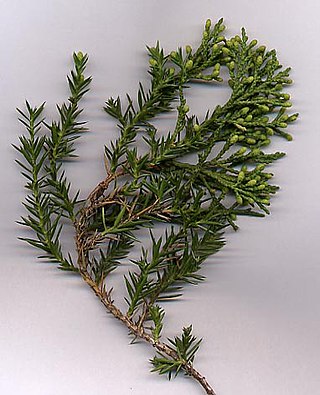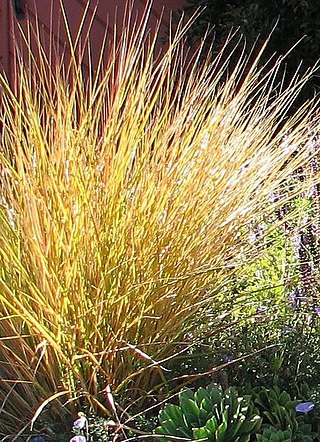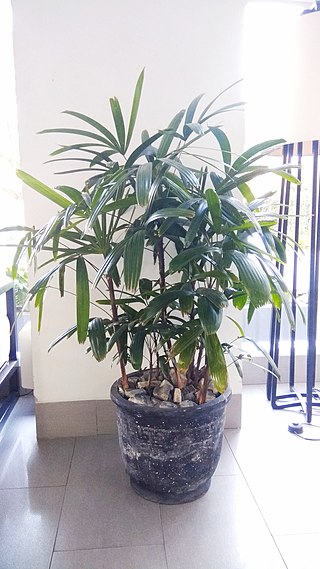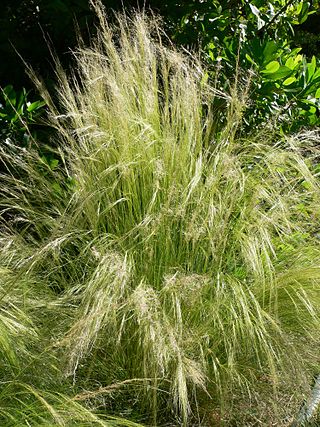
Stipa is a genus of around 300 large perennial hermaphroditic grasses collectively known as feather grass, needle grass, and spear grass. They are placed in the subfamily Pooideae and the tribe Stipeae, which also contains many species formerly assigned to Stipa, which have since been reclassified into new genera.

Juniperus chinensis, the Chinese juniper, is a species of plant in the cypress family Cupressaceae, native to China, Myanmar, Japan, Korea and the Russian Far East. Growing 1–20 metres tall, it is a very variable coniferous evergreen tree or shrub.

Ornamental grasses are grasses grown as ornamental plants. Ornamental grasses are popular in many colder hardiness zones for their resilience to cold temperatures and aesthetic value throughout fall and winter seasons.

Yucca filamentosa, Adam's needle and thread, is a species of flowering plant in the family Asparagaceae native to the southeastern United States. Growing to 3 metres tall, it is an evergreen shrub valued in horticulture.

Lavandula angustifolia, formerly L. officinalis, is a flowering plant in the family Lamiaceae, native to the Mediterranean. Its common names include lavender, true lavender and English lavender ; also garden lavender, common lavender and narrow-leaved lavender.

Juniperus squamata, the flaky juniper, or Himalayan juniper is a species of coniferous shrub in the cypress family Cupressaceae, native to the Himalayas and China.

Anemanthele is a genus of plants in the grass family native to New Zealand.

Bistorta affinis, the Himalayan bistort, fleece flower, or knotweed, is a species of flowering plant in the family Polygonaceae, native to the Himalayas.

Aristolochia gigantea, the Brazilian Dutchman's pipe or giant pelican flower, is an ornamental plant native to Brazil. Typical of subtropical Bahia and Minas Gerais vegetation, it is a vigorous evergreen climber (vine) with heart-shaped leaves and spectacular fragrant flowers. This plant is cited in Flora Brasiliensis by Carl Friedrich Philipp von Martius. A. gigantea and other tropical Dutchman's pipe varieties pose a threat to the pipevine swallowtail butterfly. The butterfly confuses A. gigantea with its native host plant and will lay eggs on it although pipevine swallowtail caterpillars cannot survive on the foliage.

Helictotrichon sempervirens, the blue oat grass, is a species of flowering plant in the true grass family, Poaceae, native to central and southwest European grasslands. It is a bunchgrass often used as an ornamental grass in garden design and landscaping.

Rhapis excelsa, also known as broadleaf lady palm or bamboo palm, is a species of fan palm in the genus Rhapis. It is native to southern China and northern Vietnam. The genus name is Greek - rhapis, meaning "needle"; and the species name is Latin for "tall", though R. excelsa is not the tallest in the genus.

Hakonechloa is a genus of bunchgrass in the tribe Molinieae of the grass family, Poaceae, native to eastern Asia.

Yucca gigantea is a species of flowering plant in the asparagus family, native to Mexico and Central America. Growing up to 8–12 m (26–39 ft) in height, it is an evergreen shrub which is widely cultivated as an ornamental garden or house plant, often referred to simply as yucca cane. The edible flower is the national flower of El Salvador locally called izote, and it is used extensively in Salvadoran cuisine.

Liriope muscari is a species of flowering plant from East Asia. Common names in English include big blue lilyturf, lilyturf, border grass, and monkey grass. This small herbaceous perennial has grass-like evergreen foliage and lilac-purple flowers which produce single-seeded berries on a spike in the fall. It is invasive to North America and considered a threat to native wildlife.

Achnatherum calamagrostis is a species of flowering plant in the grass family Poaceae, known by the common names spear grass, needle grass, and silver spike grass. It is an ornamental grass native to the clearings in the mountains of central and southern Europe, which grows in mounds of blue-green leaves and long, silvery plumes.

Pennisetum alopecuroides, the Chinese pennisetum, Chinese fountaingrass, dwarf fountain grass, foxtail fountain grass, or swamp foxtail grass, is a species of perennial grass native to Asia and Australia. The culms are erect, and 60–100 cm long. The leaf-blades are erect or drooping; flat, or conduplicate or involute (spiral); and from 10 to 45 cm long by 3–6 mm wide.

Abelia chinensis, commonly known as Chinese abelia, is a species of flowering plant in the honeysuckle family Caprifoliaceae. It is a semi-evergreen, densely branched shrub with dark green foliage.

Vesalea floribunda, also known as Mexican abelia, is a species of flowering plant in the honeysuckle family, Caprifoliaceae. It is a shrub native to southern Mexico, ranging from central Veracruz to northern Oaxaca and southeastern Chiapas.

Nassella tenuissima is a species of grass known by the common names Mexican feathergrass, finestem needlegrass, fineleaved nassella, and Argentine needle-grass. It is native to the south-western United States, northern Mexico and Argentina. It is well-matched to climate in Australia and can be harmful to the Australian environment.

Nassella charruana, the lobed needle grass, is a species of bunchgrass in the family Poaceae, native to southern Brazil, Uruguay, and northeastern Argentina, and introduced to Victoria, Australia. As its synonym Stipa charruana it has gained the Royal Horticultural Society's Award of Garden Merit as an ornamental.




















